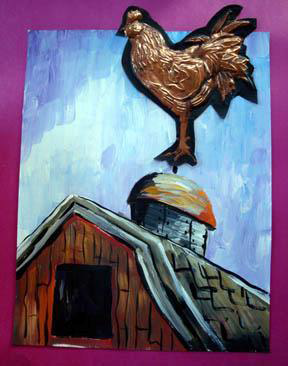For thousands of years, artists have made beautiful objects out of metal. Metal relief sculptures can be created from many materials, such as copper, aluminum, and metal foils. These materials can be molded and incised. Artists and craftsmen have used hammers to pound designs into the flat surface of metal to form relief sculpture. This method of working with metal is called embossing or repousse.
Goal (Terminal Objective):
Students will recognize embossing/repousse as the art of creating relief sculptures on metal. Students will examine artworks made in this manner and create a metal embossing of a weathervane to be placed on an acrylic landscape painting.
Objective:
Students will compare and contrast metal relief art exemplars from diverse cultures and times.
Students will understand that artists use line variety to show textures and patterns in art.
Students will identify how different kinds of lines are used in master exemplars.
Students will identify embossing as a relief sculpture art form.
Students will be able to identify weathervanes as objects that have been part of American folk art since Colonial times.
Students will plan and execute a copper or foil embossing.
National Standards:
Visual Arts Grades 9-12 Content Standard 1: Understanding and applying media, techniques, and processes
Visual Arts Grades 9-12 Content Standard 3: Choosing and evaluating a range of subject matter, symbols, and ideas
Visual Arts Grades 9-12 Content Standard 5: Reflecting upon and assessing the characteristics and merits of their work and the work of others. Social Studies Cross Curriculum Connection
Purpose:
Students will become aware of variations of media, techniques, and processes used to investigate pattern and texture in an artwork. Students will create a relief sculpture using metal in the form of a weathervane. Students will recognize that actual texture can be felt as well as seen. Students will be able to define emboss and repousse. Students will recognize and illustrate the understanding that different tools or materials can contribute to the creation of lines and textures. They will exhibit growth in skills, techniques, and procedures with a tangible art medium. They will be able to relate information on the use of weathervanes in American history.
New Vocabulary:
actual texture, implied texture, pattern, repeat, elements of art, principles of art, repousse, emboss, engraved, incised
Materials:
Art magazines for image sources, White Bristol Pencil, and a variety of Sargent Art materials for the students to choose from, such as:

#66-5421 Acrylic Set
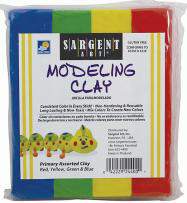
#22-4400 Primary Assorted Modeling Clay

#22-1103 Craft Glue

#22-9111 11 ct. Sculpting Tool Set

#23-40xx 50 ct. Construction Paper
Cardboard, masking tape, old ball point pens, copper tools, wooden sticks
Time:
This lesson may be modified from one to five hours, depending upon the size and complexity of expectations.
Introduction and Motivation (Set):
Discuss examples of relief sculpture. Have students identify raised surfaces and details. Have students look at coins to identify parts that are in relief. Explain that metal relief sculpture has been an art form for many years and in many different cultures.
View exemplars of weathervanes as part of a study of American Folk Art.
Discuss the use of the weather vane as a meteorological instrument and as a symbol to represent a belief, business, service, etc.
Instruction:
Teacher will provide safety rules for working with copper or metal foil. Teacher will demonstrate rendering sketches for the final project. Teacher demonstrates placing the selected sketch on top of heavy foil, copper, or metal sheeting. While working on a piece of cardboard or a pad of soft paper, the teacher will draw over the lines with a ball point pen, pressing hard so that the design will be incised into the foil.
The teacher will demonstrate using a wooden stick or spoon pressing out on the back of the foil design to make the shapes stick out on the front of the design. This should be done on cardboard. Teacher demonstrates turning the design onto the table or hard surface front side up and pressing the background down with a flat stick, wooden ruler edge, or popsicle stick. Teacher will demonstrate using a ball point pen to incise smaller details into the back of the metal design while placed on cardboard. Teacher will demonstrate painting the completed foil design and using tissue to rub off wet paint, leaving paint in the cracks or incised designs of the artwork. Teacher will refer to farmvisuals to demonstrate composing a landscape or sky painting with a roof of a barn as the center of interest. Teacher will demonstrate gluing copper weathervane copper relief to the landscape painting.
Activities:
(1) Guided Practice:
- Students render several sketches of images to be used as the weathervane motif.
- Students will tape selected sketch to a piece of copper or foil and use a ball point pen to draw over image transferring image to copper.
- After the design is transferred to the copper or foil, students will remove the sketch. Place copper or foil on cardboard and go over all lines with ball point pen.
- Students press out image from the back of design remembering to keep the copper or foil oncardboard.
- Students will work from the center of design to the outer edges. As the copper is pressed out, students will turn copper to front side, place on a hard surface, and press background flat using a flattool.
- Students continuously work from back to front remembering to keep the copper or foil on cardboard when pressing out from the back and to place the copper or foil on a hard surface when pressing flat thebackground.
- Students will use ball point pen to impart texture to the back of the copper design allowing lines to be seen from the front of the copperdesign.
- Students cut out weathervane image fromcopper.
- Students press modeling clay into the back recess of the metal relief toprevent it fromcollapsing.
- Students will paint black acrylic over copper design and remove fromsurface with a tissue, allowing black acrylic paint to remain in cracks of pattern texture.
- Students will paint the flat edges of the copper reliefsculpture.
- 12. Students will compose a landscape painting featuring a sky and the roof of a barn and glue copper or foil weathervane motif to the top of the barn.
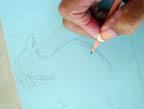
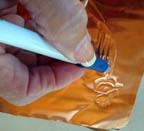
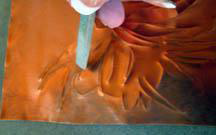
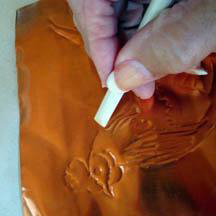
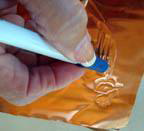
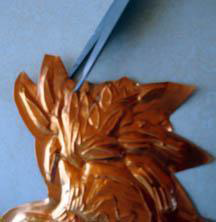
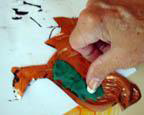
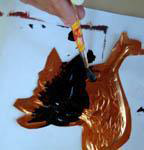
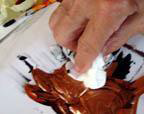
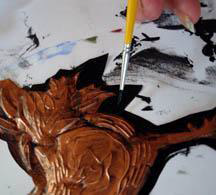
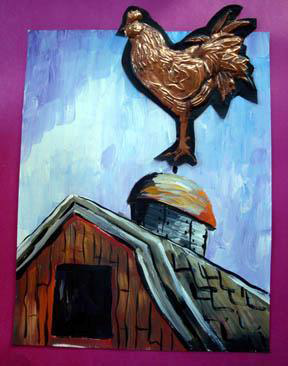
(2) Independent Practice and Check forUnderstanding:Teacher circulates among working students visually recording students demonstrating understanding of objectives and providesreinforcement.
(3) Closure: Students record the conveyed and the elements used to convey those feelings similar to the exemplar. They will include innovations they provided to the piece.
Evaluation:
Teacher/student critique and/or individual evaluation.
Level One — The finished copper embossing weathervane painting shows an excellent understanding of the capacity of metal or foil as an art medium. The student successfully lists objects from various cultures made with the metal embossing technique. The student considered a wide variety of images for the final embossing design. The image rendered for the copper embossing shows successful identification of those motifs used by American Folk artists. The copper embossing was done successfully and safely with excellent craftsmanship. The student successfully identifies the properties of the media and creates a successful landscape background for the weathervane motif. The student worked independently and remained on task.
Level Two — The finished copper embossing weathervane painting shows a good understanding of the capacity of metal or foil as an art medium. The student can list at least one object from various cultures made with the metal embossing technique. The student considered several images for the final embossing design. The image rendered for the copper embossing shows adequate identification of those motifs used by American Folk artists. The copper embossing was done adequately and safely with good craftsmanship. The student successfully identified the properties of the media and creates an adequate landscape background for the weathervane motif. The student worked independently and remained on task.
Level Three — The finished copper embossing weathervane painting shows little understanding of the capacity of metal or foil as an art medium. The student cannot list at least one object from various cultures made with the metal embossing technique. The student generated one image for the final embossing design. The image rendered for the copper embossing shows adequate identification of those motifs used by American Folk artists. The copper embossing was done adequately and safely with good craftsmanship. The student identified one property of the media and created an adequate landscape background for the weathervane motif. The student needed coaxing to work independently and remainontask.
Level Four — The finished copper embossing weathervane painting shows a poor understanding of the capacity of metal or foil as an art medium. The student cannot list at objects from various cultures made with the metal embossing technique. The student makes little or no attempt to evaluate images for the design. The image rendered for the copper embossing shows no identification of those motifs used by American Folk artists. The copper embossing was done adequately and safely with good craftsmanship. The student needed coaxing to produce a background for the weathervane motif. The student did not work independently.
Extension:
Students may lay tin foil over a design made of cardboard and rub tin foil into the relief design to simulate an embossing. They may then paint over the design and rub paint off the higher relief areas.
Resources:
http://www.denninger.com/history.html
http://www.brentberryarts.com/repousse.html
http://www.britannica.com/EBchecked/topic/185592/embossing#tab=active~checked%2Citems~checked&title=embossing%20%20Britannica%20Online%20Encyclopedia
http://ezinearticles.com/?TheHistoryOfWeatherVanes&id=409741
Art Consultant



